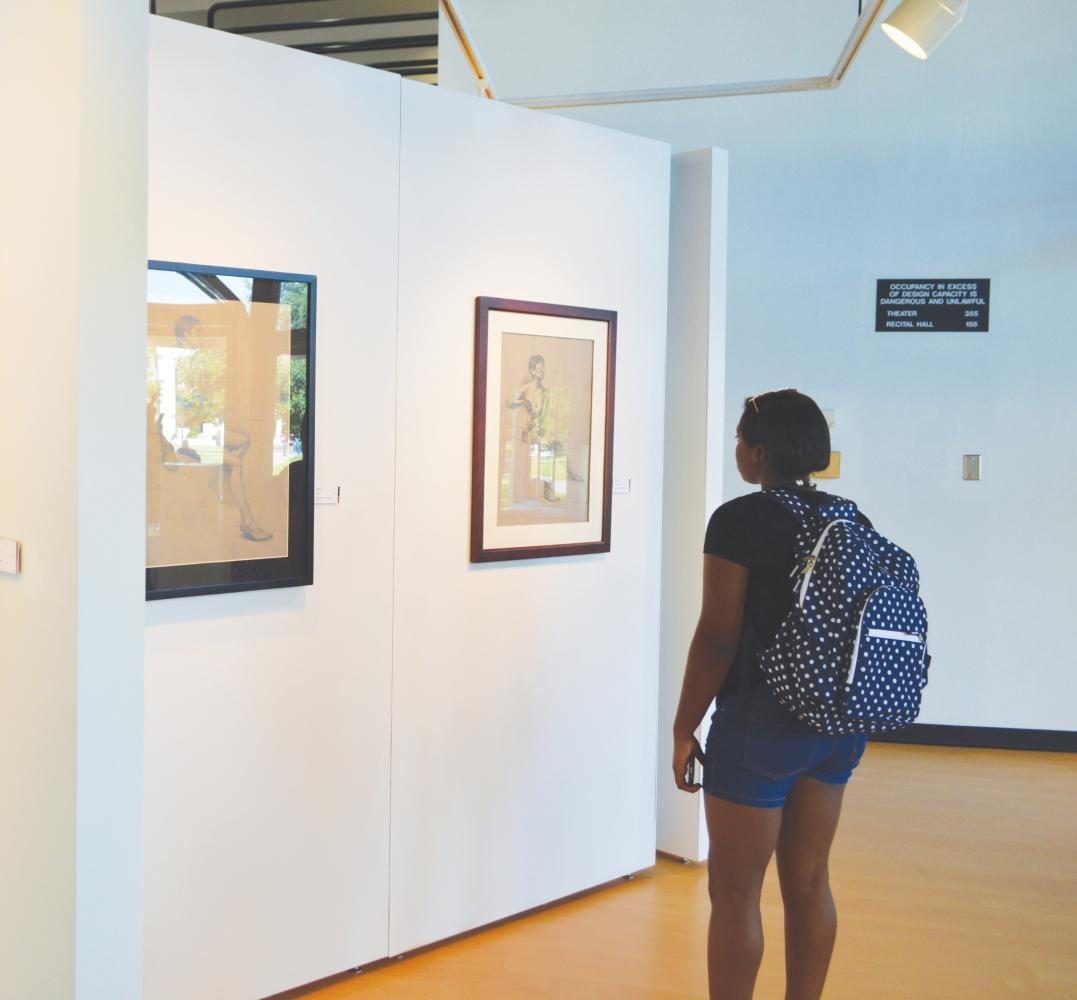Gallery presents artists of the Carolinas
Photo by: Kyle Graham
Students look at the art by Vilas Tonape and Kate Furman that is on display in the Hyman Fine Arts Center. The gallery focuses on the use of human form and natural elements.
The FMU Fine Arts Department is displaying the work of two artists for five weeks in the Hyman Fine Arts Center (FAC) gallery. The artwork ranged from figurative art to handmade jewelry.
The artist reception was held on Sept. 5 but the artwork itself will be on display until Sept. 28.
The first artist featured in the gallery is Vilas Tonape, who is chair of the department of art at Methodist University in Fayettville, N.C.
Tonape creates art, based on the Sanskrit words “rasa” and “kruti,” meaning aesthetics and visual art. A native of India, Tonape uses these concepts throughout his artwork.
Shelly Smith, senior education major, said the artist’s Indian heritage comes out in his work.
“At first glance, Indian culture appears absent from the works of art,” Smith said. “But at second glance, the use of vibrant colors in the abstract art reminds me of colorful silk saris that many Indian women wear.”
According to Walter W. Sallenger, art gallery curator for the FAC, Tonape enjoys working with the human form in his art, as can be seen in his piece “Listening is Gold Also” located on his website. This piece depicts a human ear unattached to a body and was created with charcoal on a board.
“Human form to me is a very engaging form,” Tonape said, according to the FMU website. “Even more captivating is the uniqueness and idiosyncratic perfection of each member of our human race.”
Smith said she enjoyed Tonape’s use of human form.
“For the majority of the works I viewed, the artist uses the human form in a naturalistic sense,” Smith said. “However, in some works, the artist uses human anatomy as inanimate objects, which are the focal points of each work.”
Smith said she felt that these portrait-style paintings conveyed a raw emotion that was relatable.
“The portrait style works make me feel as if the people within them are real and have a story behind them,” Smith said. “They pique my curiosity in wanting to know the back story.”
Smith said she viewed the artist’s work on his website and noticed his abstract art as well. She said his use of lines was interesting.
“The abstract art differs in its use of precise straight lines,” Smith said. “The vertical and horizontal lines provided me a way to view the abstract works, almost as if giving it a sense of order.”
The Palm Beach Post describes Tonape’s work as classically inspired, contemporary realism. The FMU website said that his work adheres to traditional art while also doing something new.
Tonape earned his Bachelor of Fine Arts in Drawing and Painting from the Sir J.J. School of Art, University of Bombay, India and his Master of Fine Arts in Painting from Texas Christian University in Fort Worth, Texas.
His work has been exhibited in multiple cities across the U.S. and globally.
The work of Kate Furman, a Greenville, S.C. native, is also being exhibited in the gallery. Furman specializes in jewelry and metalworking and earned her Bachelor of Fine Arts at the University of Georgia, in Athens, Ga. Furman furthered her education by earning a Master of Fine Arts in Jewelry and Metalsmithing.
Furman now has a studio in the Village of West Greenville in addition to teaching at the Greenville Center for Creative Arts.
According to the FMU website, Furman said her artwork tells stories.
“They tell of storms weathered and turbulent whitewater navigated,” Furman said, according to the FMU website. “I collect things while I am wandering in wilderness. They’re part of the natural cycle, undisturbed and unprotected, and I aim to highlight their undulations and ornate subtleties.”
Furman said each of her pieces represents where it was found and the purpose it had, and she described the collection as her journal.
